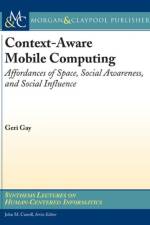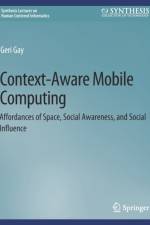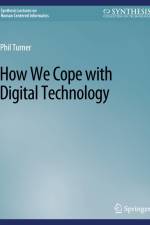Bøger i Synthesis Lectures on Human-Centered Informatics serien
-
451,95 kr. - Bog
- 451,95 kr.
-
- Spatial Cognition and Geographical Information Science
478,95 kr. With GIS technologies ranging from Google Maps and Google Earth to the use of smart phones and in-car navigation systems, spatial knowledge is often acquired and communicated through geographic information technologies. This monograph describes the interplay between spatial cognition research and use of spatial interfaces.
- Bog
- 478,95 kr.
-
- Affordances of Space, Social Awareness, and Social Influence
382,95 kr. - Bog
- 382,95 kr.
-
580,95 kr. During the last decade, cell phones with multimodal interfaces based on combined new media have become the dominant computer interface worldwide. Multimodal interfaces support mobility and expand the expressive power of human input to computers. They have shifted the fulcrum of human-computer interaction much closer to the human. This book explains the foundation of human-centered multimodal interaction and interface design, based on the cognitive and neurosciences, as well as the major benefits of multimodal interfaces for human cognition and performance. It describes the data-intensive methodologies used to envision, prototype, and evaluate new multimodal interfaces. From a system development viewpoint, this book outlines major approaches for multimodal signal processing, fusion, architectures, and techniques for robustly interpreting users' meaning. Multimodal interfaces have been commercialized extensively for field and mobile applications during the last decade. Research also is growing rapidly in areas like multimodal data analytics, affect recognition, accessible interfaces, embedded and robotic interfaces, machine learning and new hybrid processing approaches, and similar topics. The expansion of multimodal interfaces is part of the long-term evolution of more expressively powerful input to computers, a trend that will substantially improve support for human cognition and performance. Table of Contents: Preface: Intended Audience and Teaching with this Book / Acknowledgments / Introduction / Definition and Typre of Multimodal Interface / History of Paradigm Shift from Graphical to Multimodal Interfaces / Aims and Advantages of Multimodal Interfaces / Evolutionary, Neuroscience, and Cognitive Foundations of Multimodal Interfaces / Theoretical Foundations of Multimodal Interfaces / Human-Centered Design of Multimodal Interfaces / Multimodal Signal Processing, Fusion, and Architectures / Multimodal Language, Semantic Processing, and Multimodal Integration / Commercialization of Multimodal Interfaces / Emerging Multimodal Research Areas, and Applications / Beyond Multimodality: Designing More Expressively Powerful Interfaces / Conclusions and Future Directions / Bibliography / Author Biographies
- Bog
- 580,95 kr.
-
310,95 kr. This book explores the possibility for an anthropology of services and outlines a practice approach to designing services. The reader is taken on a journey that Blomberg and Darrah have been on for the better part of a decade from their respective positions helping to establish a services research group within a large global enterprise and an applied anthropology master's program at a Silicon Valley university. They delve into the world of services to understand both how services are being conceptualized today and the possible benefits that might result from taking an anthropological view on services and their design. The authors argue that the anthropological gaze can be useful precisely because it combines attention to details of everyday life with consideration of the larger milieu in which those details make sense. Furthermore, it asks us to reflect upon and assess our own perspectives on that which we hope to understand and change. Central to their exploration is the question of how to conceptualize and engage with the world of services given their heterogeneity, the increasing global importance of the service economy, and the possibilities introduced for an engaged scholarship on service design. While discourse on services and service design can imply something distinctively new, the authors point to parallels with what is known about how humans have engaged with each other and the material world over millennia. Establishing the ubiquity of services as a starting point, the authors go on to consider the limits of design when the boundaries and connections between what can be designed and what can only be performed are complex and deeply mediated. In this regard the authors outline a practice approach to designing that acknowledges that designing involves participating in a social context, that design and use occur in concert, that people populate a world that has been largely built by and with others, and that formal models of services are impoverished representations of human performance. An Anthropology of Services draws attention to the conceptual and methodological messiness of service worlds while providing the reader with strategies for intervening in these worlds for human betterment as complex and challenging as that may be. Table of Contents: Preface / Acknowledgments / Getting Started / From Services to Service Worlds / The Human Condition / Service Concepts / Design and its Limits / Service Design / An anthropology of Services / References / Author Biographies
- Bog
- 310,95 kr.
-
548,95 kr. Peer-to-peer exchange is a type of sharing that involves the transfer of valued resources, such as goods and services, among members of a local community and/or between parties who have not met before the exchange encounter. It involves online systems that allow strangers to exchange in ways that were previously confined to the realm of kinship and friendship. Through the examples in this book, we encounter attempts to foster the sharing of goods and services in local communities and consider the intricacies of sharing homes temporarily with strangers (also referred to as hospitality exchange or network hospitality). Some of the exchange arrangements discussed involve money while others explicitly ban participants from using it. All rely on digital technologies, but the trickiest challenges have more to do with social interaction than technical features. This book explores what makes peer-to-peer exchange challenging, with an emphasis on reciprocity, closeness, and participation: How should we reciprocate? How might we manage interactions with those we encounter to attain some closeness but not too much? What keeps people from getting involved or draws them into exchange activities that they would rather avoid? This book adds to the growing body of research on exchange platforms and the sharing economy. It provides empirical examples and conceptual grounding for thinking about interpersonal challenges in peer-to-peer exchange and the efforts that are required for exchange arrangements to flourish. It offers inspiration for how we might think and design differently to better understand and support the efforts of those involved in peer-to-peer exchange. While the issues cannot be simply ¿solved¿ by technology, it matters which digital tools an exchange arrangement relies on, and even seemingly small design decisions can have a significant impact on what it is like to participate in exchange processes. The technologies that support exchange arrangements¿often platformsof some sort¿can be driven by differing sets of values and commitments. This book invites students and scholars in the Human¿Computer Interaction community, and beyond, to envision and design alternative exchange arrangements and future economies.
- Bog
- 548,95 kr.
-
580,95 kr. What can Human-Computer Interaction (HCI) learn from art? How can the HCI research agenda be advanced by looking at art research? How can we improve creativity support and the amplification of that important human capability? This book aims to answer these questions. Interactive art has become a common part of life as a result of the many ways in which the computer and the Internet have facilitated it. HCI is as important to interactive art as mixing the colours of paint are to painting. This book reviews recent work that looks at these issues through art research. In interactive digital art, the artist is concerned with how the artwork behaves, how the audience interacts with it, and, ultimately, how participants experience art as well as their degree of engagement. The values of art are deeply human and increasingly relevant to HCI as its focus moves from product design towards social benefits and the support of human creativity. The book examines these issues and brings together a collection of research results from art practice that illuminates this significant new and expanding area. In particular, this work points towards a much-needed critical language that can be used to describe, compare and frame research in HCI support for creativity.
- Bog
- 580,95 kr.
-
273,95 kr. This book is an account of how I addressed the need for a smartphone app that would allow someone with Type 1 diabetes to self-manage their condition.Its presentation highlights the major features of the app¿s interface design. They include the selection of metaphors appropriate to a user¿s need to form a mental model of the app; the importance of visible context; the benefits of consistency; and considerations of a user¿s cognitive and perceptual abilities. The latter is a key feature of the book.But the book is also about the design process, and especially about the valuable contributions made by the many focus group meetings in which design ideas were first presented to people with Type 1 diabetes. Their critique, and sometimes their rejection, of interface ideas were crucial to the development of the app.I hope this book will prove useful for teaching and design guidance.
- Bog
- 273,95 kr.
-
310,95 kr. People rely on implicit interaction in their everyday interactions with one another to exchange queries, offers, responses, and feedback without explicit communication. A look with the eyes, a wave of the hand, the lift of the door handle¿small moves can do a lot to enable joint action with elegance and economy. This work puts forward a theory that these implicit patterns of interaction with one another drive our expectations of how we should interact with devices. I introduce the Implicit Interaction Framework as a tool to map out interaction trajectories, and we use these trajectories to better understand the interactions transpiring around us. By analyzing everyday implicit interactions for patterns and tactics, designers of interactive devices can better understand how to design interactions that work or to remedy interactions that fail. This book looks at the ¿smart,¿ ¿automatic,¿ and ¿interactive¿ devices that increasingly permeate our everyday lives¿doors, switches, whiteboards¿and provides a close reading of how we interact with them. These vignettes add to the growing body of research targeted at teasing out the factors at play in our interactions. I take a look at current research, which indicates that our reactions to interactions are social, even if the entities we are interacting with are not human. These research insights are applied to allow us to refine and improve interactive devices so that they work better in the context of our day-to-day lives. Finally this book looks to the future, and outlines considerations that need to be taken into account in prototyping and validating devices that employ implicit interaction. Table of Contents: Acknowledgments / Introduction / The Theory and Framework for Implicit Interaction / Opening the Door to Interaction / Light and Dark: Patterns in Interaction / Action and Reaction: The Interaction Design Factory/Driving into the Future, Together / Bibliography / Author Biography
- Bog
- 310,95 kr.
-
580,95 kr. The Envisionment and Discovery Collaboratory (EDC) is a long-term research platform exploring immersive socio-technical environments in which stakeholders can collaboratively frame and solve problems and discuss and make decisions in a variety of application domains and different disciplines.The knowledge to understand, frame, and solve these problems does not already exist, but is constructed and evolves in ongoing interactions and collaborations among stakeholders coming from different disciplines providing a unique and challenging environment to study, foster, and support human-centered informatics, design, creativity, and learning.At the social level, the EDC is focused on the collaborative construction of artifacts rather than the sharing of individually constructed items. It brings individuals together in face-to-face meetings, encouraging and supporting them to engage, individually and collectively, in action and reflection. At the technological level, the EDC integrates tabletop computing environments, tangible objects, sketching support, geographic information systems, visualization software, and an envisioned virtual implementation.This book is based on 20 years of research and development activities that brought together interdisciplinary teams of researchers, educators, designers, and practitioners from different backgrounds. The EDC originated with the merging of two research paradigms from disparate disciplines to build on the strengths, approaches, and perspectives of each. This book describes the artifacts and scenarios that were developed, with the goal of providing inspiration for human-centered informatics not focused on technologies in search of a purpose but on the development of systems supporting stakeholders to explore personally meaningful problems.These developments have inspired numerous research and teaching activities. The challenges, prototypical systems, and lessons learned represent important milestones in the development and evolution of the EDC that are relevant for future research activities and practices in human-centered informatics.
- Bog
- 580,95 kr.
-
537,95 kr. This book introduces Participatory Design to researchers and students in Human¿Computer Interaction (HCI). Grounded in four strong commitments, the book discusses why and how Participatory Design is important today. The book aims to provide readers with a practical resource, introducing them to the central practices of Participatory Design research as well as to key references. This is done from the perspective of Scandinavian Participatory Design. The book is meant for students, researchers, and practitioners who are interested in Participatory Design for research studies, assignments in HCI classes, or as part of an industry project. It is structured around 11 questions arranged in 3 main parts that provide the knowledge needed to get started with practicing Participatory Design. Each chapter responds to a question about defining, conducting, or the results of carrying out Participatory Design. The authors share their extensive experience of Participatory Design processes and thinking by combining historical accounts, cases, how-to process descriptions, and reading lists to guide further readings so as to grasp the many nuances of Participatory Design as it is practiced across sectors, countries, and industries.
- Bog
- 537,95 kr.
-
248,95 kr. Technologies that electronically mediate conversation, such as text-based chat or desktop video conferencing, draw on theories of humanhuman interaction to make predictions about the effects of design decisions. This lecture reviews the theory that has been most influential in this area: Clark's theory of language use. The key concept in Clark's theory is that of common ground. Language is viewed as a collaborative activity that uses existing common ground to develop further common ground and, hence, to communicate efficiently. The theory (a) defines different kinds of common ground, (b) formalizes the notion of collaborative activity as a "e;joint action,"e; and (c) describes the processes by which common ground is developed through joint action. Chapter 1 explains why a purely cognitive model of communication is not enough and what is meant by the phrase "e;collaborative activity."e; Chapter 2 introduces the idea of common ground and how it is used in language through an example of two people conversing over a video link. Chapter 3 indicates where the interested reader can find out about the antecedents to Clark's theory. Chapter 4 sets out the fundamental concepts in Clark's theory. Chapter 5 uses five published case studies of electronically mediated communication to illustrate the value of the theory. These include studies of a computer-supported meeting room (Cognoter), a video tunnel that supports gaze awareness, video conferencing in medical consultation, and text chat. Table of Contents: Motivation - Conversation as a Collaborative Activity / Overview - Developing Common Ground, An Example / Scientific Foundations / The Theory in More Detail / Case Studies - Applying the Theory to Electronically Mediated Communication / Current Status
- Bog
- 248,95 kr.
-
334,95 kr. Semiotic engineering was originally proposed as a semiotic approach to designing user interface languages. Over the years, with research done at the Department of Informatics of the Pontifical Catholic University of Rio de Janeiro, it evolved into a semiotic theory of human-computer interaction (HCI). It views HCI as computer-mediated communication between designers and users at interaction time. The system speaks for its designers in various types of conversations specified at design time. These conversations communicate the designers' understanding of who the users are, what they know the users want or need to do, in which preferred ways, and why. The designers' message to users includes even the interactive language in which users will have to communicate back with the system in order to achieve their specific goals. Hence, the process is, in fact, one of communication about communication, or metacommunication. Semiotic engineering has two methods to evaluate the quality of metacommunication in HCI: the semiotic inspection method (SIM) and the communicability evaluation method (CEM). Up to now, they have been mainly used and discussed in technical contexts, focusing on how to detect problems and how to improve the metacommunication of specific systems. In this book, Clarisse de Souza and Carla Leitao discuss how SIM and CEM, which are both qualitative methods, can also be used in scientific contexts to generate new knowledge about HCI. The discussion goes into deep considerations about scientific methodology, calling the reader's attention to the essence of qualitative methods in research and the kinds of results they can produce. To illustrate their points, the authors present an extensive case study with a free open-source digital audio editor called Audacity. They show how the results obtained with a triangulation of SIM and CEM point at new research avenues not only for semiotic engineering and HCI but also for other areas of computer science such as software engineering and programming. Table of Contents: Introduction / Essence of Semiotic Engineering / Semiotic Engineering Methods / Case Study with Audacity / Lessons Learned with Semiotic Engineering Methods / The Near Future of Semiotic Engineering
- Bog
- 334,95 kr.
-
533,95 kr. In this book, Clarisse de Souza and Carla Leitao discuss how the semiotic inspection method and communicability evaluation method, which are both qualitative methods, can also be used in scientific contexts to generate new knowledge about HCI. The discussion goes into deep considerations about scientific methodology, calling the reader's attention to the essence of qualitative methods in research.
- Bog
- 533,95 kr.
-
248,95 kr. The integration of ubiquitous mobile computing resources into physical spaces can potentially affect the development, maintenance, and transformation of communities and social interactions and relations within a particular context or location. Ubiquitous mobile computing allows users to engage in activities in diverse physical locations, to access resources specific to the location, and to communicate directly or indirectly with others. Mobile technologies can potentially enhance social interactions and users' experiences, extend both social and informational resources available in context, and greatly alter the nature and quality of our interactions. Activities using mobile devices in context generate complex systems of interactions, and the benefits of ubiquity and mobility can be easily lost if that complexity is not appreciated and understood. This monograph attempts to address issues of using and designing location-based computing systems and the use of these tools to enhance social awareness, navigate in spaces, extend interactions, and influence others. Table of Contents: Introduction / Space, Place, and Context / Creating a Sense of Presence and Awareness with Mobile Tools / Mobile Computing: A Tool for Social Influence to Change Behavior / Ethical Issues and Final Thoughts
- Bog
- 248,95 kr.
-
248,95 kr. This book explores the design process for user experience and engagement, which expands the traditional concept of usability and utility in design to include aesthetics, fun and excitement. User experience has evolved as a new area of Human Computer Interaction research, motivated by non-work oriented applications such as games, education and emerging interactive Web 2.0. The chapter starts by examining the phenomena of user engagement and experience and setting them in the perspective of cognitive psychology, in particular motivation, emotion and mood. The perspective of aesthetics is expanded towards interaction and engagement to propose design treatments, metaphors, and interactive techniques which can promote user interest, excitement and satisfying experiences. This is followed by reviewing the design process and design treatments which can promote aesthetic perception and engaging interaction. The final part of the chapter provides design guidelines and principles drawn from the interaction and graphical design literature which are cross-referenced to issues in the design process. Examples of designs and design treatments are given to illustrate principles and advice, accompanied by critical reflection. Table of Contents: Introduction / Psychology of User Engagement / UE Design Process / Design Principles and Guidelines / Perspectives and Conclusions
- Bog
- 248,95 kr.
-
310,95 kr. We live in an "e;information age,"e; but information is only useful when it is interpreted by people and applied in the context of their goals and activities. The volume of information to which people have access is growing at an incredible rate, vastly outstripping people's ability to assimilate and manage it. In order to design technologies that better support information work, it is necessary to better understand the details of that work. In this lecture, we review the situations (physical, social and temporal) in which people interact with information. We also discuss how people interact with information in terms of an "e;information journey,"e; in which people, iteratively, do the following: recognise a need for information, find information, interpret and evaluate that information in the context of their goals, and use the interpretation to support their broader activities. People's information needs may be explicit and clearly articulated but, conversely, may be tacit, exploratory and evolving. Widely used tools supporting information access, such as searching on the Web and in digital libraries, support clearly defined information requirements well, but they provide limited support for other information needs. Most other stages of the information journey are poorly supported at present. Novel design solutions are unlikely to be purely digital, but to exploit the rich variety of information resources, digital, physical and social, that are available. Theories of information interaction and sensemaking can highlight new design possibilities that augment human capabilities. We review relevant theories and findings for understanding information behaviours, and we review methods for evaluating information working tools, to both assess existing tools and identify requirements for the future. Table of Contents: Introduction: Pervasive Information Interactions / Background: Information Interaction at the Crossroads of Research Traditions / The Situations: Physical, Social and Temporal / The Behaviors: Understanding the "e;Information Journey"e; / The Technologies: Supporting the Information Journey / Studying User Behaviors and Needs for Information Interaction / Looking to the Future / Further Reading
- Bog
- 310,95 kr.
-
334,95 kr. This book is about HCI research in an industrial research setting. It is based on the experiences of two researchers at the IBM T. J. Watson Research Center. Over the last two decades, Drs. John and Clare-Marie Karat have conducted HCI research to create innovative usable technology for users across a variety of domains. We begin the book by introducing the reader to the context of industrial research as well as a set of common themes or guidelines to consider in conducting HCI research in practice. Then case study examples of HCI approaches to the design and evaluation of usable solutions for people are presented and discussed in three domain areas: - item Conversational speech technologies, - item Personalization in eCommerce, and - item Security and privacy policy management technologies In each of the case studies, the authors illustrate and discuss examples of HCI approaches to design and evaluation that worked well and those that did not. They discuss what was learned over time about different HCI methods in practice, and changes that were made to the HCI tools used over time. The Karats discuss trade-offs and issues related to time, resources, and money and the value derived from different HCI methods in practice. These decisions are ones that need to be made regularly in the industrial sector. Similarities and differences with the types of decisions made in this regard in academia will be discussed. The authors then use the context of the three case studies in the three research domains to draw insights and conclusions about the themes that were introduced in the beginning of the book. The Karats conclude with their perspective about the future of HCI industrial research. Table of Contents: Introduction: Themes and Structure of the Book / Case Study 1: Conversational Speech Technologies: Automatic Speech Recognition (ASR) / Case Study 2: Personalization in eCommerce / Case Study 3: Security and Privacy Policy Management Technologies / Insights and Conclusions / The Future of Industrial HCI Research
- Bog
- 334,95 kr.
-
310,95 kr. Experience-centered design, experience-based design, experience design, designing for experience, user experience design. All of these terms have emerged and gained acceptance in the Human-Computer Interaction (HCI) and Interaction Design relatively recently. In this book, we set out our understanding of experience-centered design as a humanistic approach to designing digital technologies and media that enhance lived experience. The book is divided into three sections. In Section 1, we outline the historical origins and basic concepts that led into and flow out from our understanding of experience as the heart of people's interactions with digital technology. In Section 2, we describe three examples of experience-centered projects and use them to illustrate and explain our dialogical approach. In Section 3, we recapitulate some of the main ideas and themes of the book and discuss the potential of experience-centered design to continue the humanist agenda by giving a voice to those who might otherwise be excluded from design and by creating opportunities for people to enrich their lived experience with and through technology. Table of Contents: How Did We Get Here? / Some Key Ideas Behind Experience-Centered Design / Making Sense of Experience in Experience-Centered Design / Experience-Centered Design as Dialogue / What do We Mean by Dialogue? / Valuing Experience-Centered Design / Where Do We Go from Here?
- Bog
- 310,95 kr.
-
334,95 kr. Activity theory -- a conceptual framework originally developed by Aleksei Leontiev -- has its roots in the socio-cultural tradition in Russian psychology. The foundational concept of the theory is human activity, which is understood as purposeful, mediated, and transformative interaction between human beings and the world. Since the early 1990s, activity theory has been a visible landmark in the theoretical landscape of Human-Computer Interaction (HCI). Along with some other frameworks, such as distributed cognition and phenomenology, it established itself as a leading post-cognitivist approach in HCI and interaction design. In this book we discuss the conceptual foundations of activity theory and its contribution to HCI research. After making the case for theory in HCI and briefly discussing the contribution of activity theory to the field (Chapter One) we introduce the historical roots, main ideas, and principles of activity theory (Chapter Two). After that we present in-depth analyses of three issues which we consider of special importance to current developments in HCI and interaction design, namely: agency (Chapter Three), experience (Chapter Four), and activity-centric computing (Chapter Five). We conclude the book with reflections on challenges and prospects for further development of activity theory in HCI (Chapter Six). Table of Contents: Introduction: Activity theory and the changing face of HCI / Basic concepts and principles of activity theory / Agency / Activity and experience / Activity-centric computing / Activity theory and the development of HCI
- Bog
- 334,95 kr.
-
334,95 kr. Human-centered informatics (HCI) is a young discipline that is still defining its core components, with approaches rooted in engineering, science, and creative design. In the spirit of this book series, this book explores HCI as an intersection point for different perspectives of computing and information technology, seeking to understand how groups of designers can communicate with an increasingly diverse set of colleagues on a broadening set of problems. In so doing, this book traces the evolution of claims as a way to capture and share knowledge, particularly in comparison to other approaches like patterns and issues. Claims can be a centrally important aspect in HCI design efforts, either consciously by targeted design techniques or through ingrained habits of experienced designers. An examination of claims, their uses in design, and the possibilities for explicit use in future collaborative design endeavors seeks to inspire their further development use in HCI design. Table of Contents: What are Claims? / Knowing and Sharing / Evolution of Claims / Using Claims / Looking Forward
- Bog
- 334,95 kr.
-
334,95 kr. This lecture describes a theoretical framework for the behavioural sciences that holds high promise for theory-driven research and design in Human-Computer Interaction. The framework is designed to tackle the adaptive, ecological, and bounded nature of human behaviour. It is designed to help scientists and practitioners reason about why people choose to behave as they do and to explain which strategies people choose in response to utility, ecology, and cognitive information processing mechanisms. A key idea is that people choose strategies so as to maximise utility given constraints. The framework is illustrated with a number of examples including pointing, multitasking, skim-reading, online purchasing, Signal Detection Theory and diagnosis, and the influence of reputation on purchasing decisions. Importantly, these examples span from perceptual/motor coordination, through cognition to social interaction. Finally, the lecture discusses the challenging idea that people seek to find optimal strategies and also discusses the implications for behavioral investigation in HCI.
- Bog
- 334,95 kr.
-
457,95 kr. Translating Euclid reports on an effort to transform geometry for students from a stylus-and-clay-tablet corpus of historical theorems to a stimulating computer-supported collaborative-learning inquiry experience. The origin of geometry was a turning point in the pre-history of informatics, literacy, and rational thought. Yet, this triumph of human intellect became ossified through historic layers of systematization, beginning with Euclid's organization of the Elements of geometry. Often taught by memorization of procedures, theorems, and proofs, geometry in schooling rarely conveys its underlying intellectual excitement. The recent development of dynamic-geometry software offers an opportunity to translate the study of geometry into a contemporary vernacular. However, this involves transformations along multiple dimensions of the conceptual and practical context of learning. Translating Euclid steps through the multiple challenges involved in redesigning geometry education to take advantage of computer support. Networked computers portend an interactive approach to exploring dynamic geometry as well as broadened prospects for collaboration. The proposed conception of geometry emphasizes the central role of the construction of dependencies as a design activity, integrating human creation and mathematical discovery to form a human-centered approach to mathematics. This book chronicles an iterative effort to adapt technology, theory, pedagogy and practice to support this vision of collaborative dynamic geometry and to evolve the approach through on-going cycles of trial with students and refinement of resources. It thereby provides a case study of a design-based research effort in computer-supported collaborative learning from a human-centered informatics perspective.
- Bog
- 457,95 kr.
-
334,95 kr. Digital technology has become a defining characteristic of modern life. Almost everyone uses it, we all rely on it, and many of us own a multitude of devices. What is more, we all expect to be able to use these technologies "e;straight out the box."e; This lecture discusses how we are able to do this without apparent problems. We are able to use digital technology because we have learned to cope with it. "e;To cope"e; is used in philosophy to mean "e;absorbed engagement,"e; that is, we use our smart phones and tablet computers with little or no conscious effort. In human-computer interaction this kind of use is more often described as intuitive. While this, of course, is testament to improved design, our interest in this lecture is in the human side of these interactions. We cope with technology because we are familiar with it. We define familiarity as the readiness to engage with technology which arises from being repeatedly exposed to it-often from birth. This exposure involves the frequent use of it and seeing people all around us using it every day. Digital technology has become as common a feature of our everyday lives as the motor car, TV, credit card, cutlery, or a dozen other things which we also use without conscious deliberation. We will argue that we cope with digital technology in the same way as we do these other technologies by means of this everyday familiarity. But this is only half of the story. We also regularly support or scaffold our use of technology. These scaffolding activities are described as "e;epistemic actions"e; which we adopt to make it easier for us to accomplish our goals. With digital technology these epistemic actions include appropriating it to more closer meet our needs. In summary, coping is a situated, embodied, and distributed description of how we use digital technology. Table of Contents: Introduction / Familiarity / Coping / Epistemic Scaffolding / Coping in Context / Bibliography / Author Biography
- Bog
- 334,95 kr.
-
457,95 kr. Large surface computing devices (wall-mounted or tabletop) with touch interfaces and their application to collaborative data analysis, an increasingly important and prevalent activity, is the primary topic of this book. Our goals are to outline the fundamentals of surface computing (a still maturing technology), review relevant work on collaborative data analysis, describe frameworks for understanding collaborative processes, and provide a better understanding of the opportunities for research and development. We describe surfaces as display technologies with which people can interact directly, and emphasize how interaction design changes when designing for large surfaces. We review efforts to use large displays, surfaces or mixed display environments to enable collaborative analytic activity. Collaborative analysis is important in many domains, but to provide concrete examples and a specific focus, we frequently consider analysis work in the security domain, and in particular the challenges security personnel face in securing networks from attackers, and intelligence analysts encounter when analyzing intelligence data. Both of these activities are becoming increasingly collaborative endeavors, and there are huge opportunities for improving collaboration by leveraging surface computing. This work highlights for interaction designers and software developers the particular challenges and opportunities presented by interaction with surfaces. We have reviewed hundreds of recent research papers, and report on advancements in the fields of surface-enabled collaborative analytic work, interactive techniques for surface technologies, and useful theory that can provide direction to interaction design work. We also offer insight into issues that arise when developing applications for multi-touch surfaces derived from our own experiences creating collaborative applications. We present these insights at a level appropriate for all members of the software design and development team. Table of Contents: List of Figures / Acknowledgments / Figure Credits / Purpose and Direction / Surface Technologies and Collaborative Analysis Systems / Interacting with Surface Technologies / Collaborative Work Enabled by Surfaces / The Theory and the Design of Surface Applications / The Development of Surface Applications / Concluding Comments / Bibliography / Authors' Biographies
- Bog
- 457,95 kr.
-
457,95 kr. Increasingly, teams are working together when they are not in the same location, even though there are many challenges to doing so successfully. Here we review the latest insights into these matters, guided by a framework that we have developed during two decades of research on this topic. This framework organizes a series of factors that we have found to differentiate between successful and unsuccessful distributed collaborations. We then review the kinds of technology options that are available today, focusing more on types of technologies rather than specific instances. We describe a database of geographically distributed projects we have studied and introduce the Collaboration Success Wizard, an online tool for assessing past, present, or planned distributed collaborations. We close with a set of recommendations for individuals, managers, and those higher in the organizations who wish to support distance work.
- Bog
- 457,95 kr.


























